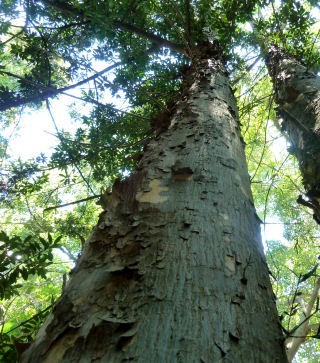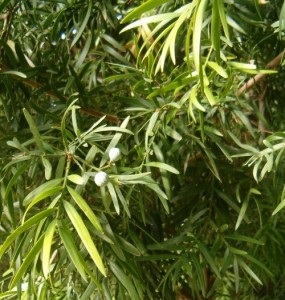Real Yellowwood – Podocarpus latifolius
(Geelhout)
Real Yellowwood occurs throughout the mountain and coastal forests from the Cape Peninsula to Natal, Transvaal and South-Eastern tropical Africa. It is a Protected Species, and is South Africa’s National Tree.
The Tree
It is a medium to tall evergreen tree and can grow to a height of 33m. The stem grows very 
The yellowish-brown bark is often fissured and peeling in narrow vertical strips. The trunk is somewhat fluted in mature trees.
The narrowly elliptic, simple alternate leaves are glassy dark green, often with a bluish tinge. Below, the surface is paler green. The margin
This is a cone-bearing tree (gymnosperm). Male cones and female structures are found on separate trees. The straw-coloured male cones are about 4.5- 5mm. The female structures consist of fleshy receptacles bearing the seeds – about 10mm long. July – September.
The round, blue-green or purple fruit – about 15mm in diameter – is borne on an enlarged, dark red receptacle. One or two are on a receptacle. They usually ripen from December to February.
The freshly picked fruit is edible when ripe.
Properties
The wood is slightly darker than that of Podocarpus falcatus (Outeniqua Yellowwood), but the difference is difficult to see, even by experts.
The wood is pale yellow, straight-grained, fine and even textured. Also soft and light to moderately heavy, slightly superior to that of Outeniqua Yellowwood. Both the heartwood and sapwood are yellow to straw-coloured, darkening to ochre with exposure. Wood from crotches of trees often has attractive figuring.
Woodworking Properties
The wood saws cleanly by hand or machine. A smooth finish can be obtained in planing. It works readily and has a fine finish. The wood glues, stains and polishes well. It is pleasant to work, but can be brittle in joints.
The wood is slightly heavier than Outeniqua yellowwood (P. falcatus) and suitable for furniture, cabinetry, domestic flooring, joinery, interior trimming and turnery. In the past, it was used for light construction, railway sleepers and boat building. It was popular for flooring and furniture in the early Cape homesteads.
These trees were once used for the masts of ships, since they grow very upright. This wood has been used more than any other indigenous timber for furniture-making. Produces a fine wood for furniture making and is often used along with darker woods such as Stinkwood and Blackwood. It was formerly the most extensively utilised species; especially for beams and floors in house building, for railway sleepers and furniture.
Green weight: 960 kg/m3
Dry weight: 560 kg/m3
Source: Trees of the Garden Route / Elna Venter
Southern African Wood / Stephanie Dyer, Barry James & Danielle James
If you are looking to buy wood, please click here to visit our Timber slab sales page.


